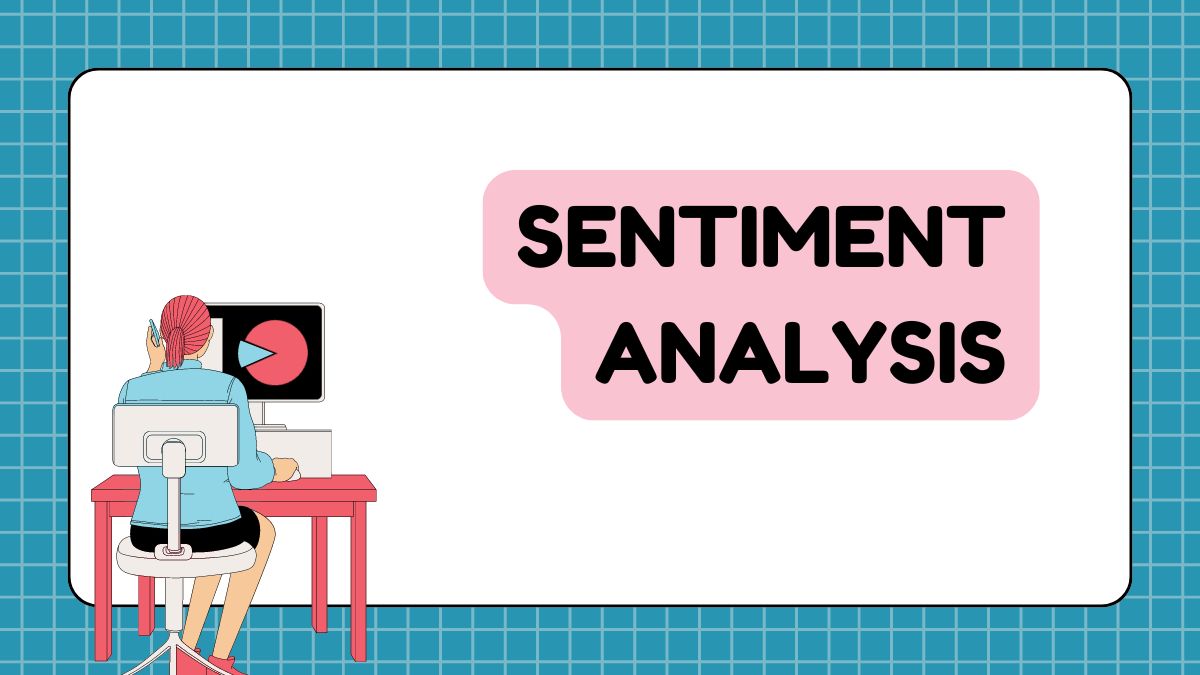As humans, we can understand emotions from texts. Sentiment analysis is one such part of NLP that dives into this aspect albeit fulfilled by machines. In this blog, we’ll cover this topic, why it’s important in NLP, and how businesses use it to read human emotions from data like tweets, reviews, and more.
Whether you’re a beginner or looking to brush up on your knowledge, this guide has something for everyone. Ready to get started? Let’s learn how to decode sentiment together!
What is Sentiment Analysis?
NLP Sentiment analysis, a subfield of NLP, is key to understanding the emotional tone of a text. Whether it’s reviews, social media posts, or customer feedback, this technique gives you public opinion.
This analysis is usually done using Python. Python has many libraries like NLTK (Natural Language Toolkit), VADER, and TextBlob that make the analysis accessible even for a beginner.
The Basics of Sentiment Analysis
The analysis is used to determine if a given text is positive, negative, or neutral. It’s used in many industries to analyse customer opinions, predict market trends, or even monitor brand reputation.
The sentiment analysis tools primarily include:
- Lexicon-based: Uses predefined dictionaries of words that have been assigned a positive, negative, or neutral score.
- Machine learning-based: Models are trained on labelled datasets to classify the sentiment of text.
To gain a better idea of this, opt for AI and ML courses that elaborate vastly on sentiment analysis tools.
Setting Up the Environment
Before we start, you need to set up your Python environment. Install the required libraries NLTK, TextBlob, and VADER.
Here’s how you can do that:
| bash
pip install nltk pip install textblob pip install vaderSentiment |
Also, don’t forget to import some additional libraries such as pandas and matplotlib for data manipulation and visualisation:
| bash
pip install pandas matplotlib |
Data Preprocessing: Cleaning the Text
Text data is often messy and contains noise like punctuation, stop words, and special characters. Cleaning the data is an essential first step to ensure accurate analysis.
Here are the steps:
- Convert to lowercase: Makes the text uniform.
- Remove punctuation and special characters: Cleans up the text.
- Tokenisation: Breaks the text into individual words or phrases.
- Stopword removal: Removes common words (e.g., “and,” “the,” “is”) that don’t contribute much to the sentiment.
Here’s how to implement this in Python using NLTK:
| import nltk
from nltk.corpus import stopwords from nltk.tokenize import word_tokenize import string # Download the stopwords package nltk.download(‘stopwords’) nltk.download(‘punkt’) # Sample text text = “The product is really good, but the service was terrible!” # Convert to lowercase text = text.lower() # Remove punctuation text = text.translate(str.maketrans(”, ”, string.punctuation)) # Tokenisation words = word_tokenize(text) # Remove stopwords filtered_words = [word for word in words if word not in stopwords.words(‘english’)] print(filtered_words) |
Lexicon-Based Sentiment Analysis
Now that our data is clean, we can apply this analysis using lexicon-based approaches. Python libraries like VADER and TextBlob make this task easy.
-
Using VADER
Here’s an example of using VADER:
| from vaderSentiment.vaderSentiment import SentimentIntensityAnalyzer
# Initialize the VADER sentiment analyzer analyzer = SentimentIntensityAnalyzer() # Analyze sentiment of a sample text text = “The product is awesome but the service was terrible!” sentiment = analyzer.polarity_scores(text) print(sentiment) Output: bash {‘neg’: 0.297, ‘neu’: 0.438, ‘pos’: 0.265, ‘compound’: -0.0516} |
Negative: 29.7%
Neutral: 43.8%
Positive: 26.5%
Compound: A single value representing the overall sentiment.
The compound score ranges from -1 (most negative) to 1 (most positive).
-
Using TextBlob
Here’s how to implement sentiment analysis using TextBlob:
| from textblob import TextBlob
# Sample text text = “The product is amazing but the service was horrible!” # Create a TextBlob object blob = TextBlob(text) # Perform sentiment analysis sentiment = blob.sentiment print(sentiment) Output: bash Sentiment(polarity=0.1, subjectivity=0.9) |
Polarity: Ranges from -1 (negative) to 1 (positive).
Subjectivity: Ranges from 0 (objective) to 1 (subjective).
Machine Learning Techniques
While lexicon-based methods are simple and effective, they may not always be accurate, especially when analysing complex texts or industry-specific jargon. Here’s an example of using scikit-learn to implement machine learning-based sentiment analysis:
| from sklearn.model_selection import train_test_split
from sklearn.feature_extraction.text import TfidfVectorizer from sklearn.linear_model import LogisticRegression from sklearn.metrics import accuracy_score # Sample dataset texts = [“The product is amazing!”, “I hate this service”, “It’s okay, not the best”] labels = [1, 0, 1] # 1 is positive, 0 is negative # Split the data into training and test sets X_train, X_test, y_train, y_test = train_test_split(texts, labels, test_size=0.2, random_state=42) # Convert text to TF-IDF features vectorizer = TfidfVectorizer() X_train_tfidf = vectorizer.fit_transform(X_train) X_test_tfidf = vectorizer.transform(X_test) # Train a logistic regression model model = LogisticRegression() model.fit(X_train_tfidf, y_train) # Predict sentiment predictions = model.predict(X_test_tfidf) # Evaluate the model accuracy = accuracy_score(y_test, predictions) print(f”Accuracy: {accuracy}”) |
Wrap Up
Sentiment analysis in Python is easy and works well with the right tools and libraries. While lexicon-based methods like VADER and TextBlob are easy to use and work well for simple tasks, more advanced use cases require machine learning-based approaches.
For professionals looking to use AI strategically an executive programme in AI for Business is the way to go. These programs offer leaders the knowledge to use AI in decision-making, customer insights, and competitive strategy.
Grow your business by mastering AI technologies like sentiment analysis today!
Frequently Asked Questions
What is sentiment analysis?
Sentiment analysis is a technique in natural language processing (NLP) that classifies emotions or opinions in text as positive, negative, or neutral.
Why should we use sentiment analysis?
It helps businesses understand customer feedback, monitor brand reputation, and predict trends by reading public sentiment from reviews, social media, and other data sources.
What are the methods used in sentiment analysis?
Lexicon-based and machine-learning models are used, with tools like VADER, TextBlob, and more advanced machine-learning algorithms.
How accurate is NLP sentiment analysis?
Accuracy depends on the model and data quality. Lexicon-based methods are simpler while machine learning models are more precise.

